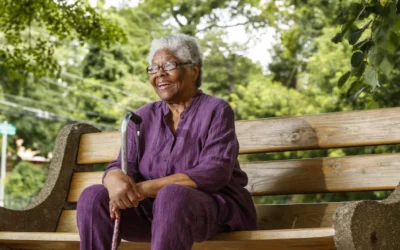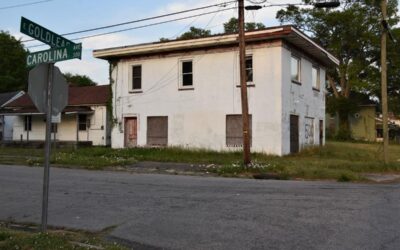WCH In the News
When you can’t afford the cost of life: Redefining poverty’s parameters
Original article courtesy of The News & Observer.
May 8, 2022. Lars Dolder, Staff Writer.
When Cherrelle Ramsey moved last year into an aging apartment near downtown Cary, it didn’t matter that she had only two rooms for her family of five. It didn’t matter that online reviews warned of rat sightings and roach infestations, or that capricious air conditioners failed during North Carolina’s sweltering summers.
Her modest space represented Ramsey’s rise from homelessness. It meant independence from government-subsidized Section 8 housing. From her apartment, Ramsey envisaged the promise of financial security that had long eluded her. As a college-educated woman with a promising career in the medical industry, poverty was not supposed to be part of her plans.
“I was one of those mothers who got married, left the city, came back, left a bad marriage, and then fell into homelessness,” said Ramsey, 35. “…I finally got some money saved and was feeling self-sufficient, but then boom.”
A medical crisis crippled her work capacity and assailed her savings. Ramsey still shoulders more than $120,000 in debt, but it’s the day-to-day cost of living that scares her most. She earns about $40,000 a year before taxes as a clinical trials coordinator. Her wages – the only earnings supporting her family – are $30,000 shy of the median household income for the Raleigh-Cary Metro Area, as defined by the U.S. Census Bureau. Ballooning prices for basic products threaten to outpace Ramsey’s stagnant salary.
“Now I feel like I’m going backwards,” she said. “My money just doesn’t go as far and it’s really been a struggle. I’m really in a situation now where I’m determining, ‘Am I going to have gas or will my kids eat?’ That’s where I’m at this week. And I got a great job. I have a great career.”
Ramsey’s dilemma afflicts many middle-income earners across the country. It’s exacerbated in areas like the Triangle where inflation exceeds the national average. Families with strong socioeconomic profiles – post-secondary school education and advanced occupations – can still be impoverished.
Their devalued dollars aren’t enough to cover the cost of life.
“I’m just praying to be financially free,” Ramsey said. “And you know, my older kids, hopefully, they’ll be off to college and finishing up with what they want to do and I’ll be able to provide for my 12- and my 4-year-old at the time. I mean, it’s really hard. Every day I worry I’m one check away from losing it all.”
Redefining our perception of poverty
Even as the lone provider for a five-person family, Ramsey’s income exceeds the federal poverty line, according to government guidelines published by the U.S. Department of Health and Human Services. She qualifies for some assistance programs such as food stamps and Medicaid, but they only defer her mounting debt.
The Federal Register for 2022 lists $32,470 a year as the poverty threshold for a family of five. Data compiled by The News & Observer suggests Ramsey can’t cover her basic expenses – excluding retirement funds, regular savings or an emergency buffer – with earnings less than $80,000.
“Oh, Jesus,” Ramsey said, when the N&O shared its findings. “I barely make half of that, even with my schooling. But yeah, I can see that being right.”
Ramsey must pay about $1,200 for groceries each month to feed her family the essentials of a healthy diet, according to March data from the U.S. Department of Agriculture. To cover the costs of housing, transportation, health care, child care and taxes in Wake County, she’d need another $6,000 at least, according to the U.S. Bureau of Labor Statistics (BLS), the U.S. Department of Housing and Urban Development and other government agencies. That totals $86,000 for the essentials of life.
Consumer goods and services across the country have increased about 8.5% in the last 12 months. If inflation’s trajectory continues, Ramsey might need more than $93,000 in annual earnings by this time next year.
“Most people talk about this problem being among low-income people,” said Jim Johnson Jr., a professor at the University of North Carolina-Chapel Hill. “That’s true, but there’s a very large working-poor population for whom the recent rise in inflation is making matters worse. These are people who, if you look at them in terms of their educational attainment, they have master’s degrees and they’re four-year college-educated and the like, but still they cannot afford to get a handle on things. I think that this inflationary trend affects a much larger number of people than one might think.”
Johnson is a specialist in business strategy and entrepreneurship and director of UNC’s Urban Investment Strategies Center. He’s one of many experts nationwide who decries the country’s antiquated calculation for evaluating poverty. The Census Bureau’s measurement weighs pre-tax income against three times the inflation-adjusted cost of food from 1963.
Mid-century assessments of poverty are myopic in light of modern-day Americans’ wide-ranging expenses. The traditional metric misrepresents many families’ economic struggles. The average family spent 17% of its disposable income on groceries in the 1960s, according to the U.S. Department of Agriculture. In 2020, U.S. consumers spent just 8.6% of their disposable income on food.
“First of all, (the federal poverty measure) is not geographically specific, as you’re aware, and it doesn’t take into account different family types based on the ages of children,” said Annie Kucklick, a research coordinator at the University of Washington’s Center for Women’s Welfare. “It doesn’t take into account costs like housing or childcare. And there are all sorts of these implicit assumptions, like for example, that one of the parents has to stay home to take care of the kids, because they’re not accounting for the cost of childcare.”
As an alternative to the government’s poverty measure, UW administers the Self-Sufficiency Standard, a metric developed at the Center for Women’s Welfare in 1996. Its founder, Diana Pearce, hoped the updated system – which accounts for location, family member ages and cost categories beyond food – might supplant its old-fashioned antecedent.
Government metrics have yet to reflect the Self-Sufficiency Standard’s more comprehensive data analysis, but organizations around the country, such as United Way, have adopted it as their system for assessing need. The N&O used previously unpublished 2022 data supplied by UW to produce its income calculator.
The Self-Sufficiency Standard yields startling figures for Triangle families. Two adults, an infant and a preschooler might need more than $85,000 a year to meet their basic costs of living in Durham County. That’s 206% more than federal guidelines suggest.
A single parent in Wake County with two elementary school-aged children needs about $65,000 – 182% more than federal poverty estimates.
For many, earning such salaries is an implausible proposition, even with esteemed careers.
“I co-founded a school in Durham for vulnerable kids,” said Johnson, a vocal proponent of the Self-Sufficiency Standard. “I had four homeless teachers a couple of years ago. Let that sink in.”
One of them, a single mother of four, earned $50,000 a year. She needed more than $95,000, according to the Self-Sufficiency Standard, to support her family in Durham.
“She was priced out of the market and had to move,” Johnson said. “And I’m talking here about what you need to cover the basics. It’s not, you know, fantastic living. It’s just covering the basics.”
Living on the edge
Dawn Taylor, 57, is a mother, business owner and veteran. She owns and operates Artistically Speaking, a gallery in downtown Durham. She served in the Army during Desert Storm. It left her “permanently and totally disabled,” per her Veterans Affairs rating.
Between Taylor’s military pension and her husband’s income as a city employee, the family thwarted escalating expenses as revitalization efforts recast Durham’s economy.
Then her husband died.
“He passed away in 2016,” Taylor said. “I’d been a stay-at-home mom and housewife. And then I went from that to being able to maintain for a while. And then it all started to kind of come apart like a house of cards.”
When Taylor moved to North Carolina in the 1990s, downtown Durham’s social scene featured “a cafe and a hotel,” she said. “And that was about it. It was affordable then.”
Now the city’s cost of living rivals Raleigh’s.
“I think everyone everywhere around here is struggling these days,” said Brenda Vann, a career researcher and Durham resident who has job hopped in search of sustainable income. “I feel like people will be recovering a little when something else comes along like COVID or childcare costs. These days, things are just continuing to be very challenged.”
To meet her family’s basic needs, Taylor must earn about $50,000, according to the Self-Sufficiency Standard. After “years struggling” in the wake of her husband’s death, she found part-time work to supplement her pension. She only has time to open her gallery on weekends or for scheduled appointments.
“I was so stressed for a while,” she said. “But even though I make enough now to get by, that’s not the same as financial security.”
Taylor estimates she would need another $30,000 to recover her previous standard of living and muster a meaningful retirement account. Sharp inflation undermines her efforts.
“There’s a difference between getting by and living comfortably,” said Gerald Cohen, chief economist at the Kenan Institute of Private Enterprise in Chapel Hill. “…There are many people that are living on the edge, and a jump in the price of staple goods really can hurt those kinds of people.”
Some economists describe inflation’s recent effects as similar to the shape of an alligator’s maw. With its jaws ajar, the alligator’s snout represents inflation’s trajectory. The mandible stands for wage increases. Both may be going up, but the gap between them is ever-widening.
“In the latest (national) employment report, hourly earnings were up 5.1% on a year-on-year basis,” Cohen told the N&O in March. “Inflation was up 7.9%. So, clearly, raises are not keeping up with inflation.”
Taylor enjoys her part-time job as a receptionist, but she’s still looking for other work that can accommodate her disability. Without a substantial salary bump, she’ll fall behind on her bills.
“Unfortunately, I think people with money may still miss the point,” she said. “They’re going to think, ‘$60,000? They can whip that up.’
“…I’m not trying to bash such people. But until you’ve struggled, you’re not going to get the visceral reaction someone like me gets when they’re told, ‘You have to make $60,000 a year,’ as if that’s just doable.”
Despite her financial challenges, Taylor is grateful to have better circumstances than many.
“I’m hoping I don’t fall into the cracks, but I’m lucky because of being a disabled vet,” she said. “They have a lot of options at least. I can go to the VA hospital and say, ‘Hey, I’m about to be homeless,’ you know? Some people don’t really have any resources.”
What would I give up to survive?
It’s crowded in Ramsey’s two-bedroom apartment. She downsized to avoid less expensive alternatives – “housing projects and stuff like that.” But the cramped space adds to her children’s agitation.
There’s no room in Ramsey’s budget for child care. Even working more than full-time hours falls short of covering the basics.
“My baby needs daycare, but since I’ve been out at work my daughter had to stay home to watch him because I can’t afford child care,” she said. “So now everybody’s lacking – the kids are lacking for school. But if I don’t work, they don’t eat. So we kind of rotate who’s going to go to school and who’s going to watch the baby.”
It shouldn’t be this way, Ramsey says. On paper, she did things right. She worked hard to put herself through college, holding onto the prospect of future payout: high wages and otherwise unattainable promotions. But her goals haven’t materialized.
“I don’t have problems getting work,” she said. “It’s the fact of getting paid what you’re working for.”
The bridge between America’s lower-income families and its highest earners spans a nebulous middle class. Many who “should be doing better,” according to Ramsey, are still falling into poverty.
“It’s a challenge without an immediate or obvious solution,” Cohen said. “There’s been this long-term widening of the gap between lower and upper incomes. People like me are making more relative to the people who are most hurt by, for example, rising gasoline and rising food prices.”
Financial strain and desperation compel some people to consider extreme behaviors to make ends meet.
“Honestly, let’s be realistic, there are ways to get money out there,” Ramsey said. “You understand? But I’m all about being legit.”
For “doing what’s right,” Ramsey must make other sacrifices. Each day she faces a harrowing question: “What would I give up to survive?”
“I don’t want to fall into that category of risking it all to survive,” she said. “But who knows what the next steps are? There’s this constant struggle that you always got to do something else. It’s to the point now where I’m like, maybe I’ll be better off living at a hotel somewhere. At least I wouldn’t have to worry about utilities.”
Now I feel like I’m going backwards. My money just doesn’t go as far and it’s really been a struggle. I’m really in a situation now where I’m determining, ‘Am I going to have gas or will my kids eat?’ That’s where I’m at this week. And I got a great job. I have a great career.
Most people talk about this problem being among low-income people. That’s true, but there’s a very large working-poor population for whom the recent rise in inflation is making matters worse. These are people who, if you look at them in terms of their educational attainment, they have master’s degrees and they’re four-year college-educated and the like, but still they cannot afford to get a handle on things.
In the latest (national) employment report, hourly earnings were up 5.1% on a year-on-year basis. Inflation was up 7.9%. So, clearly, raises are not keeping up with inflation.
Lars Dolder: @dldolder
Other News
Is There Any Gold to Mine in the Graying of America?
The over-65 population is growing faster than the generations who will take their place. Demographer James Johnson Jr. discusses the opportunities for growth given current demographic trends.
Council Hears About Possible Community Land Trust in City
A group of UNC-Chapel Hill students pitch the Rocky Mount City Council specifics of their analysis regarding how a possible community land trust could best serve city residents.
Leveraging the promise of a green economy to promote racial equity
In North Carolina, the sick-school building syndrome – an estimated $3.1 billion problem – mainly affects children of color who attend aging and rapidly deteriorating schools in both urban and rural low wealth counties.



